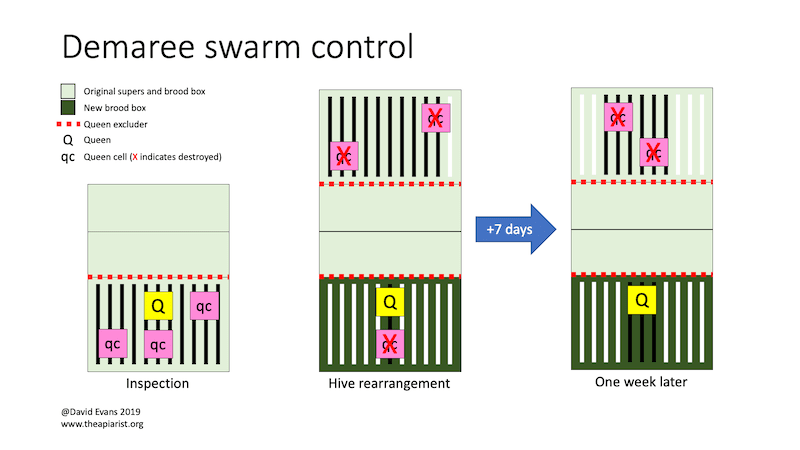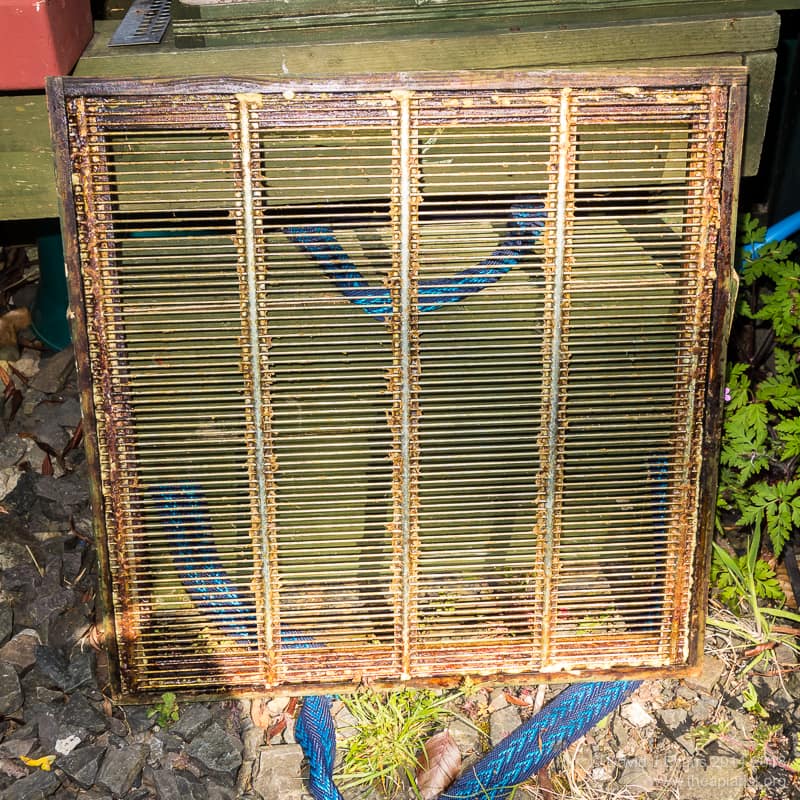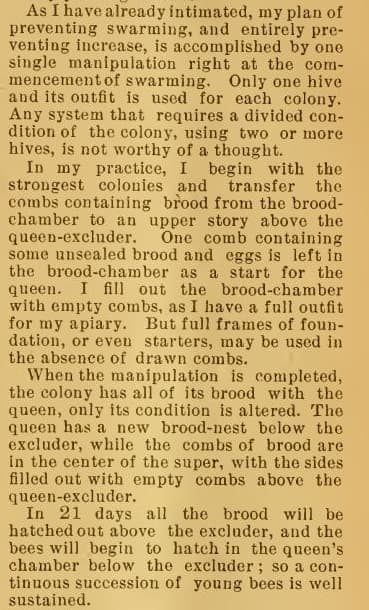Demaree swarm control
I’ve covered three swarm control methods in previous posts. These are the classic Pagden artificial swarm, the vertical split that is directly comparable but requires less equipment and more lifting, and the nucleus method.
As described on this site, if successful, all achieve the same two things:
- They prevent a swarm being lost. Don’t underestimate how important this is in terms of not irritating your neighbours, in helping your honey production and in giving you a quiet sense of satisfaction 🙂
- They result in the generation of a second colony headed by a newly mated queen.
This doubling in colony number, or – more generally – the managed reproduction of colony numbers, is termed making increase.
You're missing out … new posts are published on The Apiarist every week, and at least 50% of the content is for paid subscribers. Why not join them to guarantee your fix of beekeeping-related reading?
Managed reproduction
Making increase is of fundamental importance in beekeeping.
Without deliberately splitting colonies, unless you buy in nucs every year (kerrching!), collect swarms or steal hives {{1}} your colony numbers would never increase.
Making increase is therefore critical if you want more colonies. However, it’s just as important (and a darn sight less expensive than buying nucs) if you want to make up any overwintering colony losses, thereby keeping the same number of colonies overall {{2}}.
Not making increase
Once you’ve got bees, with good management, you can always have bees. However, at some point you reach that sweet spot where you have enough bees and don’t want more colonies.
The Goldilocks Principle is the concept of having just the right amount. Not so few colonies that a really harsh winter causes problems, and not so many that you cannot enjoy your beekeeping at the peak of the season.
When you reach that point you no longer need to make increase, you just want to keep the same number of colonies.
Which means that the swarm control methods that essentially reproduce the colony may not be ideal.
Of course, you can unite colonies having removed the unwanted queen from one of them, but this is additional work. Not a huge amount of work admittedly, but work nevertheless {{3}}.
This is where the Demaree method of swarm control comes in useful. As practised, Demaree swarm control prevents the loss of the swarm without increasing colony numbers.
It has the additional significant advantages of keeping the entire foraging force of the colony together (even better for honey production than not losing a swarm) and needing no specialised equipment.
Demaree swarm control – in principle
The principle of the method is very straightforward.

George Demaree
When queen cells are found during an inspection you conduct a form of a vertical split, separating the original queen and flying bees from the nurse bees and sealed brood. You place the latter above a queen excluder.
A few days later you return and remove any new queen cells from the top box, so preventing swarming. Finally you leave all the brood to emerge from the top box.
Demaree swarm control – in practice
A cartoon diagram of the process is shown below. The only additional equipment required is a brood box with 11 frames of drawn comb or foundation and a queen excluder.
That’s it.

Demaree swarm control
Here’s a bit more detail:
- If you find queen cells during an inspection gently remove the brood box and place it on an upturned roof off to one side {{4}}.
- Place the new brood box on the original floor. Add 9 frames of drawn comb or foundation, leaving a gap in the middle of the box.
- Using minimal smoke, go through the original box and find the queen.
- Place the frame with the queen in the middle of the new brood box on the original floor. This frame must contain no queen cells.
- Push the frames in the new brood box together and add in the eleventh frame.
- Add a queen excluder.
- Add the supers above the queen excluder. If there were no supers on the original hive then it’s worth adding a couple of supers now. It will provide better separation of the new and old brood boxes and it will encourage the bees to store nectar in supers rather than the top brood box.
- Add a second queen excluder.
- Place the original brood box on top of the queen excluder.
- Go through the upper brood box and remove every queen cell. Shake the bees off the frames to do this. Push the frames together and add one additional frame. Add the crownboard and roof.
Leave the colony for one week. At the next inspection you should only need to check the top brood box (i.e. the original one).
- Carefully inspect every frame and remove every queen cell. Again, you should shake the bees off the frames to do this. If you miss any queen cells there’s a good chance the colony will swarm.
- Close up the hive and leave the brood in the top box to emerge.
- About 25 days after conducting the first inspection (1 above, where you first found QC’s) you can remove the upper brood box from which all brood will have now emerged.
Explanatory notes
If you have a reasonable understanding of the development cycle of queen and worker bees you will understand how the Demaree Method simultaneously prevents swarming and keeps the entire colony together.

Honey bee development
- By splitting the colony you separate the queen and the flying bees from the nurse bees and the brood. The queen in the new (now bottom) box has ample space to lay, particularly if you provide her with some drawn comb to use.
- The bottom box will now be less crowded and the swarming urge will therefore be much reduced.
- You destroy all of the queen cells in the original (now top) box when you rearrange the hive. This is to stop any new queens emerging in this box in the following week.
- However, this top box still contains eggs and young larvae. Since it is now located a long way from the queenright box the level of queen pheromone is very low. Consequently, in the week following the hive rearrangement, the bees will create new emergency queen cells in the top box.
- When you return a week later all the eggs in the top box will have hatched and the youngest larvae left will be about four days old i.e. too old to be reared as new queens. Therefore, when you destroy all the new queen cells in the top box, you prevent the colony swarming.
- You can remove the top brood box as soon as all the brood has emerged i.e. 25 days after first rearranging the hive {{5}}.
Demaree pros and cons
Pros
- An effective method of swarm control
- Relatively simple procedure to implement and understand
- Only requires a single brood box, frames and a queen excluder
- Generates big, strong colonies and keeps the entire foraging force together
- Modifications of the process can be used for queen rearing {{6}}
Cons
- Necessary to find the queen
- Critical to remove all queen cells at the start and after one week
- Generates tall stacked boxes, so some heavy lifting may be involved
- Drones in the top box get trapped by the queen excluder {{7}}
- In a strong flow the bees can backfill the top box with nectar. Add sufficient supers when you first rearrange the hive

Framed wire QE …
Historical notes
George Whitfield Demaree (1832–1915) was a lawyer in Kentucky, USA, and a pioneer in swarm control methods. His eponymous method was published in the American Bee Journal in 1892. The original method was subtly different from that described above:

Demaree method
In his description he emphasises the need to keep the colony together to maximise honey production.
I suspect Demaree used a single sized box (as broods and supers) as he describes placing brood frames above the queen excluder in the centre of the super flanked by empty frames. As described, he doesn’t mention returning after one week to destroy queen cells above the queen excluder. Don’t forget to do this!
I particularly like Demaree’s comment that any swarm prevention method that “require a divided condition of the colony, using two or more hives, is not worthy of a thought”.
{{1}}: Don’t do this at home, or anywhere else for that matter.
{{2}}: Remember that it’s probably less trouble to improve your disease management and winter colony preparation to reduce losses, rather than losing colonies and then making increase the following year.
{{3}}: Usually you’ll keep the younger queen if she performs well. Don’t forget that swarm control methods that make increase have the additional benefit of enabling requeening, so reducing future swarming.
{{4}}: I’m assuming that the queen cells are unsealed. If there are sealed queen cells in the box it’s likely that the colony has swarmed, in which case it’s too late to use the Demaree swarm control method.
{{5}}: 25 days because that’s one day more than the development time for a drone.
{{6}}: These are outside the scope of this brief account and will be dealt with sometime in the future.
{{7}}: This is certainly distressing for the drones (and probably for the beekeeper). I usually try and release them every few days by lifting the lid off for a couple of minutes.
Join the discussion ...